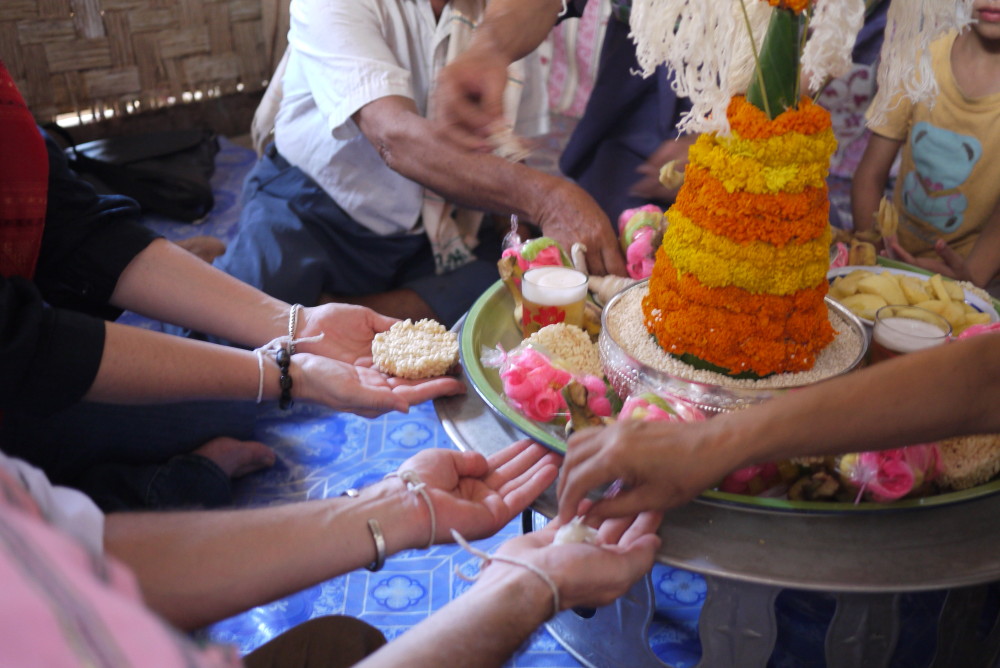Baci Ceremony
One of the last wonderful moments that Pete and I encountered on this vacation was to go to Aeng’s house and be treated to a Baci ceremony. Instead of trying to explain the significance and meaning myself, I share with you the Lao Heritage Foundation’s information, as it is far more accurate and certain ceremonial words are spelled correctly!
It goes without saying that being invited to someone’s home and participating in such a lovely and wonderful ceremony was truly one of the most special experiences I’ve had during all of my travels! Both Pete and Aeng teased me for getting teary eyed, but I was deeply moved and loved every moment spent with Aeng’s family and friends. We enjoyed lots of laughter during our ceremony and because we aren’t quite sure what was said, Pete and I are somewhat suspicious that the elders might have married us by accident! Ha!
I found a great article which better describes the significance of the ceremony.
The Baci Ceremony
Definition: Briefly the Baci is a ceremony to celebrate a special event, whether a marriage, a homecoming, a welcome, a birth, or one of the annual festivals. A mother is given a baci after she has recovered form a birth, the sick are given bacis to facilitate a cure, officials are honored by bacis, and novice monks are wished luck with a baci before entering the temple. The Baci ceremony can take place any day of the week and all year long, preferably before noon or before sunset. The term more commonly used is su kwan, which means “calling of the soul”.
Concept of Kwan
Kwan are components of the soul, but have a more abstract meaning than this. The kwan have been variously described by Westerners as: “vital forces, giving harmony and balance to the body, or part of it”, “the private reality of the body, inherent in the life of men and animals from the moment of their birth,” and simply as “vital breath”. It is an ancient belief in Laos that the human being is a union of 32 organs and that the kwan watch over and protect each one of them. It is of the utmost consequence that as many kwan as possible are kept together in the body at any one time. Since all kwan is often the attributed cause of an illness, the baci ceremony calls the kwan or souls from wherever they may be roaming, back to the body, secures them in place, and thus re-establishes equilibrium.
The Pha Kwan
The pha kwan is an arrangement consisting of a dish or bowl, often in silver, from the top of which sprouts a cone or horn made of banana leaves and containing flowers, white cotton or silk threads. The flowers used often have evocative meanings and symbols, such as dok huck (symbol of love), dok sampi (longevity), dok daohuang (cheerfulness/brilliance), etc. The cotton threads are cut at the length long enough to wrap around the adult wrists. These are attached to a bamboo stalk and give the impression of a banner.
Around the base of this is the food for the kwan. The food consists usually of hard boiled eggs (symbol of the fetus), fruits and sweets symbolizing the coming together of several parts, in this case the forming of a community (a stalk of bananas, khaotom-boiled sweet rice wrapped in banana leaves), bottle of rice whisky for purification, and boiled whole chicken with head and feet with claws for divination purposes.
The pha kwan is placed on a white cloth in the center of the room, with the maw pawn sitting facing the pha kwan. The person(s) for whom the baci is being held sits directly opposite of him, on the other side of the pha kwan. The maw pawn or mohkwan is a village elder, ideally an ex-monk who will be officiating the ceremony, chanting and calling the kwan.
The baci ceremony and the steps leading to it
1. Tdung pah kwan or the making of the pah kwan: This task of preparing and setting up the pah kwan or flower trays for the ceremony is often shared by elderly women in the community.
2. Somma or paying respect to the elders: Before the ceremony actually begins, the younger people would pay respect to the elders.
3. Keunt pah kwan or introduction of the ceremony: Everyone touches the pah kwan as the moh pohn chants Buddhist mantra.
4. Pitee hiek kwan or the calling of the kwan: The maw pawn calls upon the wandering kwan to return and inhabit the body of the person the ceremony is intended for.
5. Pook kwan or the tying of kwan: When the maw pawn finishes the invocation, he places the symbolic food into the upturned hand which the recipient has by now extended. The maw pawn then takes the cotton thread from the pha kwan and wraps it around the extended wrist, tying it there. While securing it with a few knots, he chants a shorter version of the invocation strengthening the power of the blessings.
6. Song pah kwan or the closing of the ceremony: Once the pook kwan is over, everyone touches the pah kwan again as a way to conclude the ceremony.
7. Sharing of a meal: After the ceremony, everyone shares a meal as a member of the community.
In Laos, white is the color of peace, good fortune, honesty and warmth. The white cotton thread is a lasting symbol of continuity and brotherhood in the community and permanence. The baci threads should be worn for at least three days subsequently and should be untied rather than cut off. Usually it is preferred that they are kept until they fall off by themselves.
The baci ceremony runs deep in the Lao psyche. In different part of the country the ceremony differs slightly in meaning. In general, it is nonetheless an emphasis of the value of life, of social and family bonds, of forgiveness, renewal and homage to heavenly beings.
Article by Pom Outama Khampradith, Bounheng Inversin, and Tiao Nithakhong Somsanith
Tags: culture, traditions





